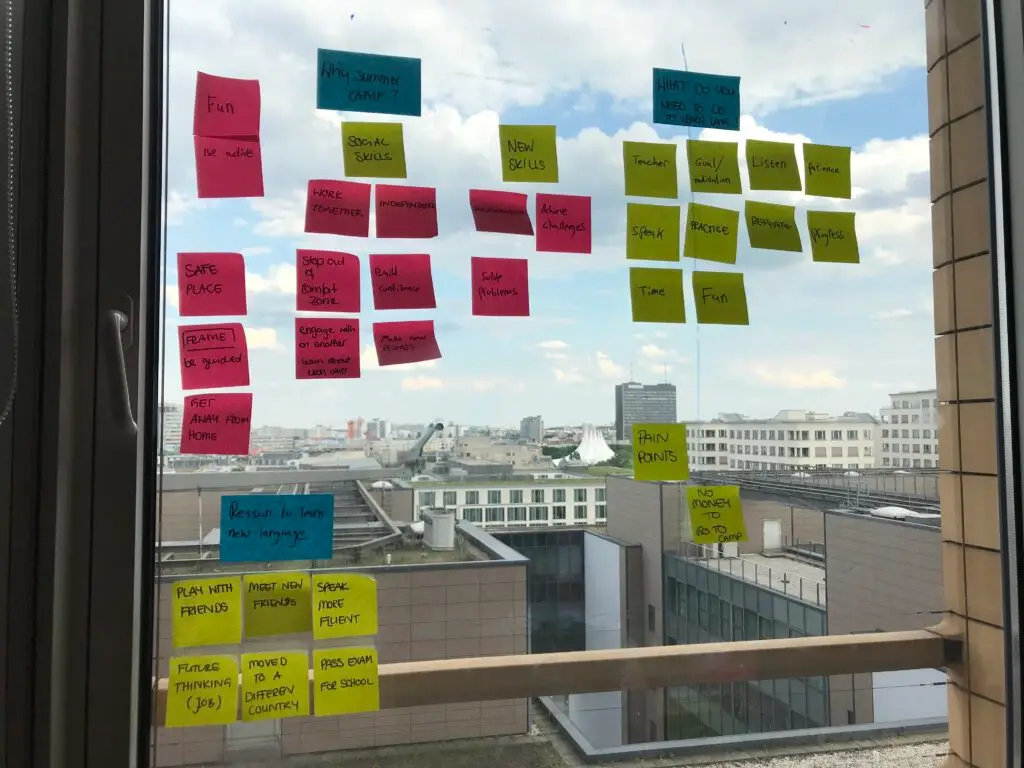
Creating a Fun, Social, and Engaging Language Learning Experience for Teens: A UX Design Journey
Motivation
The motivation for this project stems from a common barrier many teens face: the inability to participate in traditional, in-person language summer camps due to factors such as geographical location or social status. The goal is to ensure that teens can still experience the fun and effectiveness of language learning—regardless of where they are—by leveraging a 100% digital experience.
Challenge: Designing an Engaging Digital Language Learning Platform
The core challenge of this project was to reimagine the in-person language summer camp experience and transform it into a fully digital platform. The focus was specifically on UX design, with the objective of creating a mid-fidelity prototype that integrates research, ideation, prototyping, testing, and iteration. The goal was to make learning a new language not only effective but also engaging and interactive for teens.
Understanding the Users and Exploring the Market
To design a successful platform, it was crucial to understand the target audience—Generation Z (Gen Z)—and their habits, preferences, and challenges. This generation is composed of digital natives who spend a significant amount of their time online, particularly on mobile devices, making mobile-first design a necessity.
Our research revealed the following key insights about Gen Z:
- Digital natives: Comfortable navigating digital environments from a young age.
- Time online: 41% of teens spend at least three hours online daily.
- Mobile-first users: Prefer using mobile devices over desktops or tablets.
- Self-directed learners: Enjoy learning independently and at their own pace.
- Socially-driven: Value collaboration, gaming, and social interaction.
Additionally, we examined competitors in the online language learning space. The analysis highlighted that while most existing platforms use reward systems to drive engagement and offer a variety of activities to help with language acquisition, they often lack the essential social and fun elements that are crucial for Gen Z users. This gap in the market led us to focus on developing a platform with a strong social and interactive component.

Defining the Problem
After gathering our research, we entered the “Define” phase of the design thinking process. We synthesized the data to empathize more deeply with the users and gain clarity on their needs and pain points. Our findings were distilled into the following key problem statements (How Might We):
- HMW bring the summer camp experience into an app?
- HMW help teens feel confident speaking a new language?
- HMW make learning a language interactive and fun for teens?
User Persona and Journey Mapping
To ground our design process in user-centered thinking, we created detailed user personas. Lisa, Lucy, and Mateo represent our primary and secondary users, each with their own goals, challenges, and behaviors related to language learning. In addition, we mapped out the user journey of a typical summer holiday to identify high and low points in the user’s experience. This allowed us to identify opportunities for our product to enhance language learning during their downtime.
Ideation: Making Learning Fun and Social
In the “Ideate” phase, we held several brainstorming sessions, using methods like round-robin and Crazy 8s to explore creative ideas. The concept that emerged was built around making language learning 100% fun and 100% mobile while incorporating the social connection that Gen Z craves.
Introducing the Key Features
- Buddy System: One of the app’s core features is a “Buddy Up” system that matches users based on their interests. This fosters social interaction and encourages collaboration as users learn each other’s languages.
- Daily Challenges: Users can create and solve challenges for their buddy, using the new vocabulary they have learned. This gamified approach makes the learning process more dynamic and engaging.
- Goal Setting: The app allows users to learn at their own pace. As they level up, they are introduced to new buddies, making the experience fresh and rewarding.
The User Flow
The app’s onboarding process was designed to be simple and intuitive:
- Download the app and create an account.
- Input language preferences: Choose your native language and the language you want to learn.
- Choose your interests and pick your monster avatar.
- Match with a buddy to start learning together.
- Have fun by completing challenges, chatting, and leveling up!
Focusing on Safety
Safety was a top priority during the design process. To address concerns, we introduced a monster avatar system, which replaces profile pictures to prevent discrimination and keeps the focus on learning rather than personal appearance. Additionally, a “Fox” floating action button (FAB) was incorporated to oversee chat content and assist users with any questions or concerns. This feature ensures that the social interactions remain positive, respectful, and conducive to learning.
Prototyping and Testing
With the foundation of the app in place, we developed a mid-fi prototype and began testing. The first iteration was a paper prototype, which allowed us to gather initial feedback and make quick adjustments. From there, we created a clickable prototype, which we tested with several users to validate our design decisions. Each round of testing provided valuable insights, helping us refine the user flow, improve the buddy-matching algorithm, and enhance the usability of the app’s key features.
Moving forward, we will continue to iterate based on user feedback before transitioning to a high-fidelity prototype and ultimately, a fully functional platform.
Conclusion
This project was a UX design challenge aimed at creating a digital language learning platform that not only teaches but also engages teens in a fun and social way. By understanding Gen Z’s preferences, studying the competition, and empathizing with our users, we developed a unique app that reimagines the language summer camp experience in a digital environment. Our user-centered approach ensured that the design addressed key pain points, making language learning more interactive, socially driven, and accessible to all teens, regardless of their location or social status.


